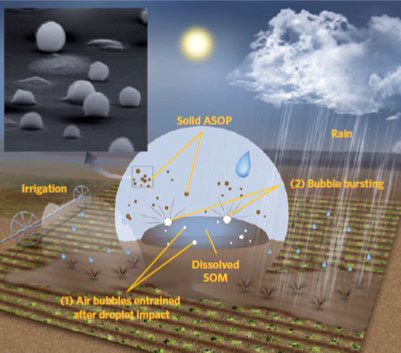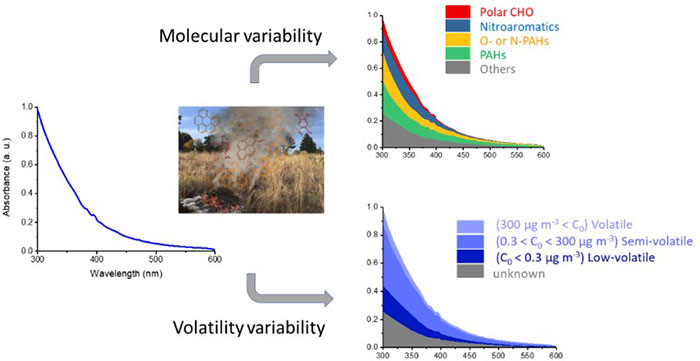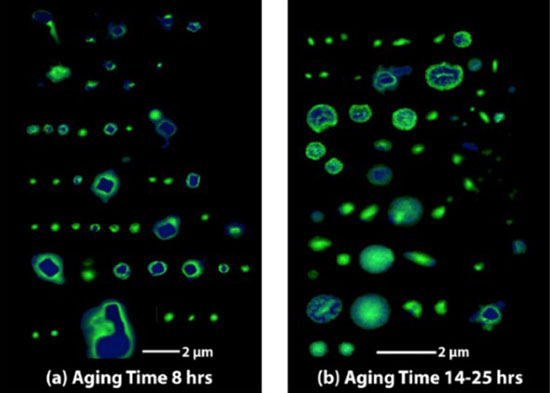Past Field Studies
Discovery of glassy atmospheric soil organic particles (ASOP)
These particles are emitted after rains through previously unrecognized atmosphere – land-surface interactions. Chemical imaging and micro-spectroscopy analysis of particle physico-chemical properties suggested that these particles may have important impacts on cloud formation and efficiently absorb solar radiation. It has been suggested that raindrop-induced formation of solid organic particles from soils may be a widespread phenomenon in ecosystems such as agricultural systems and grasslands where soils are exposed to strong, episodic precipitation events.

Image caption: A schematic illustration of the mechanism generating ASOP. 1) Raindrops impinging on the soil surface entrain air bubbles into the surface water layer containing dissolved soil organic matter. 2) The bubbles burst at the air/water interface and eject ASOP that solidify to become glassy on drying. The insert shows an SEM image of glassy ASOP collected at the Southern Great Plains, USA.
Relevant publication
B. Wang, T.H. Harder, S.T. Kelly, D.S. Piens, S. China, L. Kovarik, M. Keiluweit, B.W. Arey, M.K. Gilles, A. Laskin. Airborne soil organic particles generated by precipitation. Nature Geoscience, 9, 433-437. (2016). doi: 10.1038/NGEO2705
Molecular-level characterization of the BrC chromophores in the real world aerosol samples.
We use HPLC-PDA-HRMS platform to identify BrC chromophores present in the samples of biomass burning organic aerosols (BBOA). Several classes of BrC chromophores have been identified in these studies. A large fraction of them are biofuel-specific, while certain chromophores have common nature across different types of biofuels. In many cases, we found that the total absorbance by 20-25 individual BrC chromophores may account for ~60% of the overall BBOA absorbance. We develop approaches to estimate relative contributions of the different types of BrC chromophores by combining them into broader groups based on their chemical properties, such as similarity in molecular composition and estimated volatility. The overarching goal of these efforts is to provide practical input for future atmospheric models to simulate sources, composition and transformations of BrC.

Image caption: Relative contributions to the overall BrC absorption of a selected BBOA sample by individual chromophores grouped based on their molecular composition (upper plot) and estimated volatility (lower plot).
Relevant publications
P. Lin, N. Bluvshtein, Y. Rudich, J. Laskin, A. Laskin. Molecular Chemistry of Atmospheric Brown Carbon Inferred from a Nationwide Biomass Burning Event. Environmental Science and Technology, 51 (20), 11561–11570, (2017). doi: 10.1021/acs.est.7b02276.
P. Lin, P. Aiona, Y. Li, M. Shiraiwa, J. Laskin, S.A. Nizkorodov, A. Laskin. Molecular Characterization of Brown Carbon in Biomass Burning Aerosol. Environmental Science and Technology, 50, 11815−11824, (2016). doi: 10.1021/acs.est.6b03024
A. Laskin, J.S. Smith, J. Laskin "Molecular Characterization of Nitrogen Containing Organic Compounds in Biomass Burning Aerosols Using High Resolution Mass Spectrometry" Environmental Science and Technology, 43, 3764–3771, (2009). doi: 10.1021/es803456n
Chemical imaging of ambient particles sampled from different environments
with the focus on understanding mechanisms of particle atmospheric processing, transformations and biogenic-anthropogenic interactions. We analyze chemical changes in complex individual particles composed of inorganic and organic components and sampled in urban plumes to predictively understand processes of aerosol aging. Atmospheric aging results in modification of aerosol composition, which in turn impact acidity, hygroscopic, and optical properties of aged particles. Particle-specific analysis and mixing state metrics determined in these studies serve for more accurate modeling representation of aerosol mixing state, source apportionment, and aging in polluted versus clean natural environments.

Image caption: Chemical imaging maps of individual marine particles detected in samples collected onboard G-1 aircraft during CARES 2010 study in Central Valley, CA. Left and right panels show particles with corresponding short and long transport times from their marine source. Areas dominated by organic carbon are green, and NaCl regions are blue. After long transport particles are processed, as indicated by less dominant NaCl components, and increased areas where organics dominate.
Relevant publications
R.C. Moffet, R.E. O’Brien, P. Alpert, S.T. Kelly, D.Q. Pham, M.K. Gilles, D. Knopf, A. Laskin. Morphology and Mixing of Soot Particles Collected in Central California During the CARES Field Study. Atmospheric Chemistry and Physics, 16, 1–11, (2016). doi: 10.5194/acp-16-14515-2016
S. China, B. Wang, J. Weis, L. Rizzo, J. Brito, G. Cirino, L. Kovarik, P. Artaxo, M.K. Gilles, A. Laskin. Rupturing Of Biological Spores As A Source Of Secondary Particles In Amazonia. Environmental Science and Technology, 50, 12179−12186, (2016). doi: 10.1021/acs.est.6b02896
A. Laskin, R.C. Moffet, M.K. Gilles, J.D. Fast, R. Zaveri, B. Wang, J. Shutthanandan. Tropospheric Chemistry of Internally Mixed Sea Salt and Organic Particles: Surprising Reactivity of NaCl with Weak Organic Acids. Journal of Geophysical Research, 117, D15302, (2012). doi: 10.1029/2012JD017743
